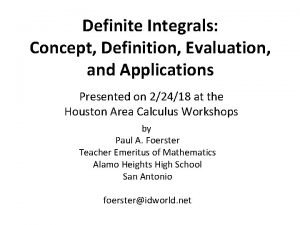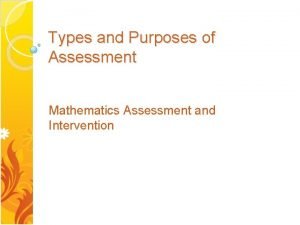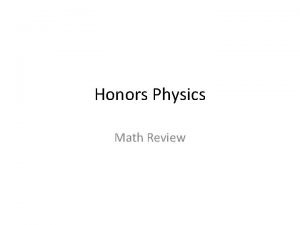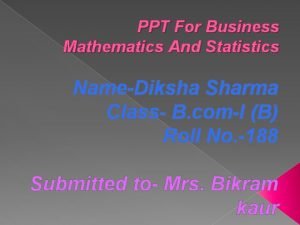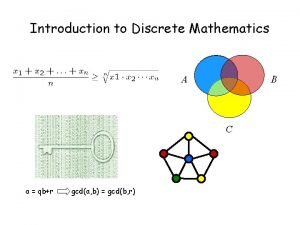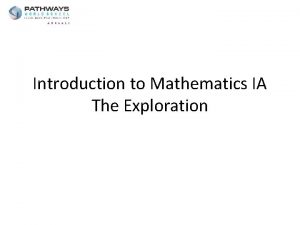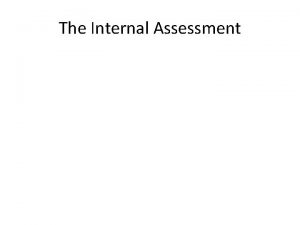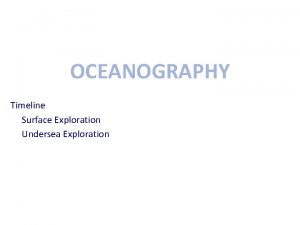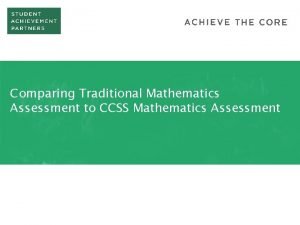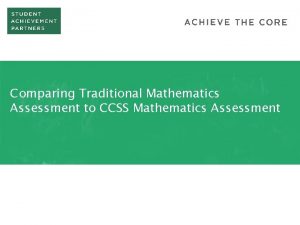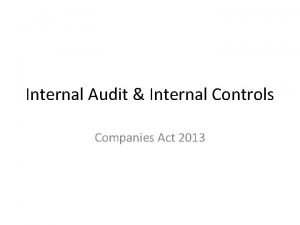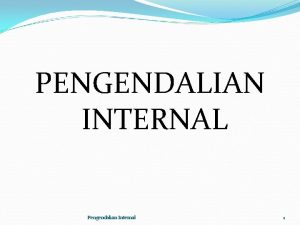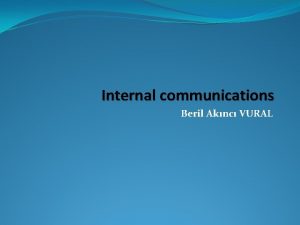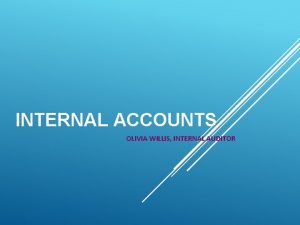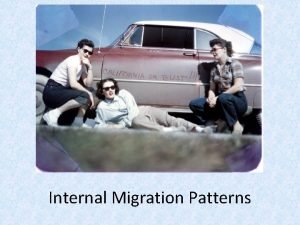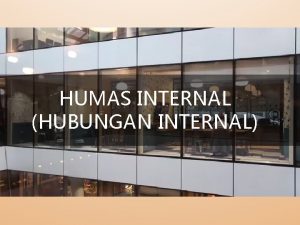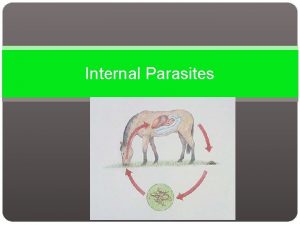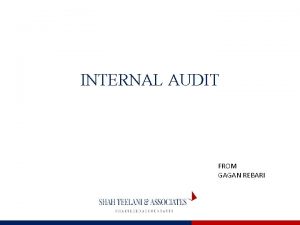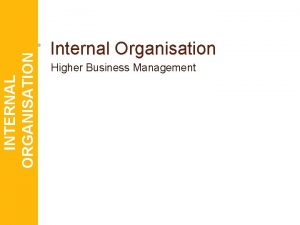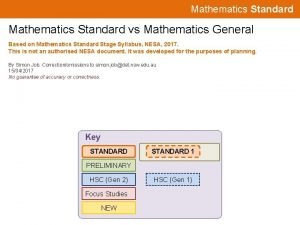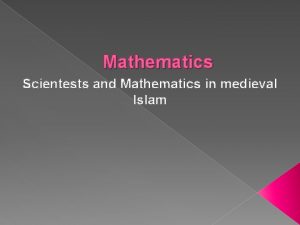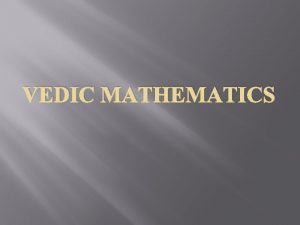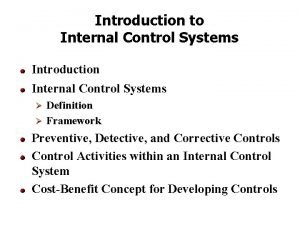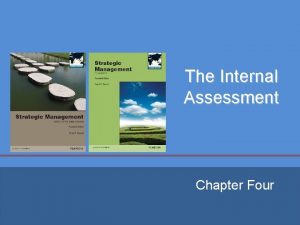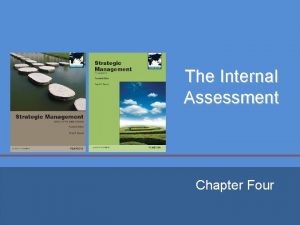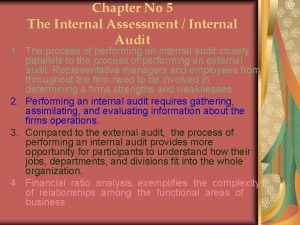Introduction to Mathematics IA The Exploration Internal assessment






































- Slides: 38

Introduction to Mathematics IA The Exploration

Internal assessment in mathematics SL is an individual exploration. This is a piece of written work that involves investigating an area of mathematics. It is marked according to five assessment criteria.

Internal assessment is an integral part of the mathematics SL course, contributing 20% to the final assessment in the course. It is expected that a total of approximately 10 teaching hours should be allocated to the work. This should include: • time for the teacher to explain to students the requirements of the exploration • class time for students to work on the exploration • time for consultation between the teacher and each student • time to review and monitor progress, and to check authenticity.

The internally assessed component in this course is a mathematical exploration. This is a short report written by the student based on a topic chosen by him or her, and it should focus on the mathematics of that particular area. The emphasis is on mathematical communication (including formulae, diagrams, graphs and so on), with accompanying commentary, good mathematical writing and thoughtful reflection. A student should develop his or her own focus, with the teacher providing feedback via, for example, discussion and interview. This will allow the students to develop area(s) of interest to them without a time constraint as in an examination, and allow all students to experience a feeling of success. The final report should be approximately 6 to 12 pages long. It can be either word processed or handwritten. Students should be able to explain all stages of their work in such a way that demonstrates clear understanding. While there is no requirement that students present their work in class, it should be written in such a way that their peers would be able to follow it fairly easily. The report should include a detailed bibliography, and sources need to be referenced in line with the IB academic honesty policy. Direct quotes must be acknowledged

Requirements and recommendations Students can choose from a wide variety of activities, for example, modelling, investigations and applications of mathematics. To assist teachers and students in the choice of a topic, a list of stimuli is available in the teacher support material. However, students are not restricted to this list. The exploration should not normally exceed 12 pages, including diagrams and graphs, but excluding the bibliography. However, it is the quality of the mathematical writing that is important, not the length.

Requirements and recommendations The teacher is expected to give appropriate guidance at all stages of the exploration by, for example, directing students into more productive routes of inquiry, making suggestions for suitable sources of information, and providing advice on the content and clarity of the exploration in the writing-up stage. Teachers are responsible for indicating to students the existence of errors but should not explicitly correct these errors. It must be emphasized that students are expected to consult the teacher throughout the process.

Requirements and recommendations All students should be familiar with the requirements of the exploration and the criteria by which it is assessed. Students need to start planning their explorations as early as possible in the course. Deadlines should be firmly established. There should be a date for submission of the exploration topic and a brief outline description, a date for the submission of the first draft and, of course, a date for completion

Requirements and recommendations In developing their explorations, students should aim to make use of mathematics learned as part of the course. The mathematics used should be commensurate with the level of the course, that is, it should be similar to that suggested by the syllabus. It is not expected that students produce work that is outside the mathematics SL syllabus—however, this is not penalized

Developing The Exploration v The topic is one that interests you. (It is easier to stay motivated and work hard) v. While deciding the topic of the exploration a student should keep in mind that there is enough scope of Mathematical analysis in the topic.

Timeline – Developing The Exploration Process Date begun Date ended Think about a stimuli Choose a topic Oct 3 rd Oct 10 th Draft exploration Nov 11 th Nov 14 th Introduction o Outline the aim and purpose in a clear and succinct manner. o Justify the exploration choice o Briefly discuss the area of mathematics that will be used. o Evidence of some research. Progress check

Timeline – Developing The Exploration Body/Mathematical Exploration o Describe the method, followed by an investigation o Record your results (tables, lists etc) o Analyse the results (graphs, diagrams, calculations etc) and form conjectures.

Timeline – Developing The Exploration Conclusion and Bibliography o Summarise your findings in response to your aim. Restate any rules, conjectures or models that you found. o Comment on any limitations to your approach, or to your findings. o Comment on possible extensions and real life connections. Relate it to your personal knowledge and to your previous knowledge. o Including a reflection on what you have learned and what you have taken away from this experience will reflect personal engagement.

Timeline – Developing The Exploration First Draft Due date Teacher to review & comment on draft Meet with teacher Final writing Revise draft Final version due date: Dec 18 th Nov 25 th Dec 1 st Dec 3 rd Dec 15 th Dec 16 th

Planning – Mind Mapping

Stimuli sport algorithms sine e space volcanoes games codes tiling viruses play biology physics archaeology cell phones musical harmony electricity orbits diet symmetry the internet population health π business chemistry psychology computers music motion water food Euler architecture communication agriculture dance geography economics information technology in a global society

Choose a stimulus and create your own mind map here.

The Assessment Criteria

The Assessment Criteria Your teacher expects these skills and strategies from you: Choosing a topic v Identifying an appropriate topic v Developing a topic v Devising a focus that is well defined and appropriate v Ensuring that the topic lends itself to a concise exploration

The Assessment Criteria Communication v Expressing ideas clearly v Identifying a clear aim for the exploration v Focusing on the aim and avoiding irrelevance v Structuring ideas in a logical manner v Including graphs, tables and diagrams at appropriate places v Editing the exploration so that it is easy to follow v Citing references where appropriate

The Assessment Criteria Mathematical presentation v Using appropriate mathematical language and representation v Defining key terms, where required v Selecting appropriate mathematical tools (including information and communication technology) v Expressing results to an appropriate degree of accuracy

The Assessment Criteria Personal engagement v Working independently v Asking questions, making conjectures and investigating mathematical ideas v Reading about mathematics and researching areas of interest v Looking for and creating mathematical models for real-world situations v Considering historical and global perspectives v Exploring unfamiliar mathematics

The Assessment Criteria Reflection v Discussing the implications of results v Considering the significance of the exploration v Looking at possible limitations and/or extensions v Making links to different fields and/or areas of mathematics

The Assessment Criteria Use of mathematics v Demonstrating knowledge and understanding v Applying mathematics in different contexts v Applying problem-solving techniques v Recognizing and explaining patterns, where appropriate v Generalizing and justifying conclusions

The Assessment Criteria

The Assessment Criteria

The Assessment Criteria

The Assessment Criteria


As part of the learning process, teachers can give advice to students on a first draft of the exploration. This advice should be in terms of the way the work could be improved, but this first draft must not be heavily annotated or edited by the teacher. The next version handed to the teacher after the first draft must be the final one.

Authenticity may be checked by discussion with the student on the content of the work, and scrutiny of one or more of the following: • the student’s initial proposal • the first draft of the written work • the references cited • the style of writing compared with work known to be that of the student

Self-Assessment When completing your self assessment, use the language of the rubrics and the teacher expectations to comment on why you have given yourself this particular grade. Set goals for yourself for each criterion.

Checklist Item Yes Partially No Have you explained the reason why you have chosen your topic in your exploration? Is the aim of your exploration included in your introduction? Do you have an introduction and conclusion? Is your exploration organized? Is the work entirely yours? Have you chosen a topic that you are interested in and developed your own ideas? Is it evident in your exploration? Have you defined key terms/variables? Have you used appropriate mathematical language (notation, symbols and terminology) consistently throughout your exploration? ** Calculator/computer notation should not be used. **

Checklist Have you used more than one form of mathematical representation? Are all graphs, tables and diagrams sufficiently described and labeled? Are formulae, graphs, tables and diagrams in the main body of the text? No full-page graphs and no separate appendices. Have you used technology to enhance your exploration? Have you explained what you are doing at all times? Explanatory comments should be seen throughout your exploration? Have you used mathematics that is commensurate with the Standard Level course (or beyond)? Is the mathematics in your exploration correct? Have you reflected on your finding at appropriate places in your exploration, particularly in your conclusion? Have you considered limitations and extensions in your reflection? Have you considered the assessment criteria when writing your exploration? Have you self assessed your exploration?

Checklist Is your exploration approximately 6 to 12 pages long? Have you referenced your work in a bibliography? Have you had someone else read your exploration to ensure that the communication is good? Does it have flow and coherence? Is it easily understandable? Does it read well? Have you completed your self-assessment? Have you submitted a first draft to your teacher and used the feedback to improve your report?

Authenticity Plagiarism This includes copying quotes, information and ideas, directly or paraphrased, from books and websites. Collusion This includes working closely with another student such that the work between the two students is similar. Ensuring academic honesty To prevent plagiarism, you need to cite your sources correctly and include any sources in your bibliography. If you have questions on how to properly cite your sources, seek advice from your teacher or from the school librarian. To prevent collusion, you should discuss ideas with other students, but you should never giver another student your work, either in print or electronically.

Recommended Technology Some examples of technology include: • any kind of calculators, the internet, data logging devices • word processing packages, spreadsheets, graphics packages • statistics packages or computer algebra packages. Great software for working with graphs, diagrams, functions, spreadsheets, statistics, calculus and much, much more. www. geogebra. org

A modern, easy-to-learn, programming language that is great for writing simulations. There are loads of tutorials available: just google “python tuts”. www. python. org An online graph plotter with graphing capabilities similar to those of your graphical calculators. www. fooplot. com

A really powerful search engine. (For example, type “find antiderivative of f(x) = 3 x” into the search bar. ) www. wolframalpha. com
 Exploration 1-3a introduction to definite integrals
Exploration 1-3a introduction to definite integrals Types of assessment in mathematics
Types of assessment in mathematics Physics math review
Physics math review Business mathematics chapter 1 ppt
Business mathematics chapter 1 ppt Introduction of mathematics
Introduction of mathematics Internal control procedure
Internal control procedure Features of vouching
Features of vouching Hình ảnh bộ gõ cơ thể búng tay
Hình ảnh bộ gõ cơ thể búng tay Slidetodoc
Slidetodoc Bổ thể
Bổ thể Tỉ lệ cơ thể trẻ em
Tỉ lệ cơ thể trẻ em Chó sói
Chó sói Glasgow thang điểm
Glasgow thang điểm Alleluia hat len nguoi oi
Alleluia hat len nguoi oi Các môn thể thao bắt đầu bằng từ đua
Các môn thể thao bắt đầu bằng từ đua Thế nào là hệ số cao nhất
Thế nào là hệ số cao nhất Các châu lục và đại dương trên thế giới
Các châu lục và đại dương trên thế giới Công thức tiính động năng
Công thức tiính động năng Trời xanh đây là của chúng ta thể thơ
Trời xanh đây là của chúng ta thể thơ Cách giải mật thư tọa độ
Cách giải mật thư tọa độ Làm thế nào để 102-1=99
Làm thế nào để 102-1=99 Phản ứng thế ankan
Phản ứng thế ankan Các châu lục và đại dương trên thế giới
Các châu lục và đại dương trên thế giới Thể thơ truyền thống
Thể thơ truyền thống Quá trình desamine hóa có thể tạo ra
Quá trình desamine hóa có thể tạo ra Một số thể thơ truyền thống
Một số thể thơ truyền thống Cái miệng xinh xinh thế chỉ nói điều hay thôi
Cái miệng xinh xinh thế chỉ nói điều hay thôi Vẽ hình chiếu vuông góc của vật thể sau
Vẽ hình chiếu vuông góc của vật thể sau Nguyên nhân của sự mỏi cơ sinh 8
Nguyên nhân của sự mỏi cơ sinh 8 đặc điểm cơ thể của người tối cổ
đặc điểm cơ thể của người tối cổ Giọng cùng tên là
Giọng cùng tên là Vẽ hình chiếu đứng bằng cạnh của vật thể
Vẽ hình chiếu đứng bằng cạnh của vật thể Tia chieu sa te
Tia chieu sa te Thẻ vin
Thẻ vin đại từ thay thế
đại từ thay thế điện thế nghỉ
điện thế nghỉ Tư thế ngồi viết
Tư thế ngồi viết Diễn thế sinh thái là
Diễn thế sinh thái là Dạng đột biến một nhiễm là
Dạng đột biến một nhiễm là
